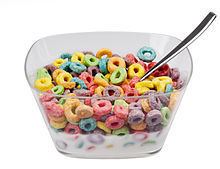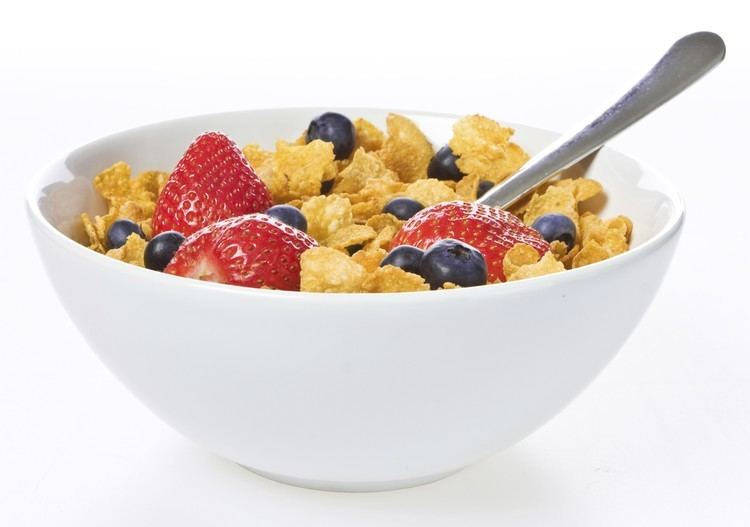Kingdom Plantae | Order Poales | |
 | ||
Similar Wheat, Maize, Rice, Barley, Grain | ||
A cereal is any grass cultivated for the edible components of its grain (botanically, a type of fruit called a caryopsis), composed of the endosperm, germ, and bran. Cereal grains are grown in greater quantities and provide more food energy worldwide than any other type of crop and are therefore staple crops. Edible grains from other plant families, such as buckwheat (Polygonaceae), quinoa (Amaranthaceae) and chia (Lamiaceae), are referred to as pseudocereals.
Contents
- Honey nut cereal bars everyday food with sarah carey
- Ancient history
- Farming
- Planting
- Harvesting
- Production
- Nutritional facts
- Standardization
- References

In their natural form (as in whole grain), cereals are a rich source of vitamins, minerals, carbohydrates, fats, oils, and protein. When refined by the removal of the bran and germ, the remaining endosperm is mostly carbohydrate. In some developing nations, grain in the form of rice, wheat, millet, or maize constitutes a majority of daily sustenance. In developed nations, cereal consumption is moderate and varied but still substantial.

The word cereal is derived from Ceres, the Roman goddess of harvest and agriculture.
Honey nut cereal bars everyday food with sarah carey
Ancient history

Agriculture allowed for the support of an increased population, leading to larger societies and eventually the development of cities. It also created the need for greater organization of political power (and the creation of social stratification), as decisions had to be made regarding labor and harvest allocation and access rights to water and land. Agriculture bred immobility, as populations settled down for long periods of time, which led to the accumulation of material goods.
Early Neolithic villages show evidence of the development of processing grain. The Levant is the ancient home of the ancestors of wheat, barley and peas, in which many of these villages were based. There is evidence of the cultivation of figs in the Jordan Valley as long as 11,300 years ago, and cereal (grain) production in Syria approximately 9,000 years ago. During the same period, farmers in China began to farm rice and millet, using man-made floods and fires as part of their cultivation regimen. Fiber crops were domesticated as early as food crops, with China domesticating hemp, cotton being developed independently in Africa and South America, and Western Asia domesticating flax. The use of soil amendments, including manure, fish, compost and ashes, appears to have begun early, and developed independently in several areas of the world, including Mesopotamia, the Nile Valley and Eastern Asia.
The first cereal grains were domesticated by early primitive humans. About 8,000 years ago, they were domesticated by ancient farming communities in the Fertile Crescent region. Emmer wheat, einkorn wheat, and barley were three of the so-called Neolithic founder crops in the development of agriculture. Around the same time, millets and rices were starting to become domesticated in East Asia. Sorghum and millets were also being domesticated in sub-Saharan West Africa.
Farming
While each individual species has its own peculiarities, the cultivation of all cereal crops is similar. Most are annual plants; consequently one planting yields one harvest. Wheat, rye, triticale, oats, barley, and spelt are the "cool-season" cereals. These are hardy plants that grow well in moderate weather and cease to grow in hot weather (approximately 30 °C, but this varies by species and variety). The "warm-season" cereals are tender and prefer hot weather. Barley and rye are the hardiest cereals, able to overwinter in the subarctic and Siberia. Many cool-season cereals are grown in the tropics. However, some are only grown in cooler highlands, where it may be possible to grow multiple crops per year.
For the past few decades, there has also been increasing interest in perennial grain plants. This interest developed due to advantages in erosion control, reduced need for fertiliser, and potential lowered costs to the farmer. Though research is still in early stages, The Land Institute in Salina, Kansas has been able to create a few cultivars that produce a fairly good crop yield.
Planting
The warm-season cereals are grown in tropical lowlands year-round and in temperate climates during the frost-free season. Rice is commonly grown in flooded fields, though some strains are grown on dry land. Other warm climate cereals, such as sorghum, are adapted to arid conditions.
Cool-season cereals are well-adapted to temperate climates. Most varieties of a particular species are either winter or spring types. Winter varieties are sown in the autumn, germinate and grow vegetatively, then become dormant during winter. They resume growing in the springtime and mature in late spring or early summer. This cultivation system makes optimal use of water and frees the land for another crop early in the growing season.
Winter varieties do not flower until springtime because they require vernalization: exposure to low temperatures for a genetically determined length of time. Where winters are too warm for vernalization or exceed the hardiness of the crop (which varies by species and variety), farmers grow spring varieties. Spring cereals are planted in early springtime and mature later that same summer, without vernalization. Spring cereals typically require more irrigation and yield less than winter cereals.
Harvesting
Once the cereal plants have grown their seeds, they have completed their life cycle. The plants die, become brown, and dry. As soon as the parent plants and their seed kernels are reasonably dry, harvest can begin.
In developed countries, cereal crops are universally machine-harvested, typically using a combine harvester, which cuts, threshes, and winnows the grain during a single pass across the field. In developing countries, a variety of harvesting methods are in use, depending on the cost of labor, from combines to hand tools such as the scythe or grain cradle.
If a crop is harvested during humid weather, the grain may not dry adequately in the field to prevent spoilage during its storage. In this case, the grain is sent to a dehydrating facility, where artificial heat dries it.
In North America, farmers commonly deliver their newly harvested grain to a grain elevator, a large storage facility that consolidates the crops of many farmers. The farmer may sell the grain at the time of delivery or maintain ownership of a share of grain in the pool for later sale. Storage facilities should be protected from small grain pests, rodents and birds.
Production
The following table shows the annual production of cereals in 1961, 2010, 2011, 2012, and 2013 ranked by 2013 production.
Maize, wheat, and rice together accounted for 89% of all cereal production worldwide in 2012, and 43% of all food calories in 2009, while the production of oats and triticale have drastically fallen from their 1960s levels.
Other cereals worthy of notice, but not included in FAO statistics, include:
Several other species of wheat have also been domesticated, some very early in the history of agriculture:
In 2013 global cereal production reached a record 2,521 million tonnes. A slight dip to 2,498 million tonnes was forecasted for 2014 by the FAO in July 2014.
Nutritional facts
Some grains are deficient in the essential amino acid, lysine. That is why many vegetarian cultures, in order to get a balanced diet, combine their diet of grains with legumes.
Many legumes, however, are deficient in the essential amino acid methionine, which grains contain. Thus, a combination of legumes with grains forms a well-balanced diet for vegetarians. Common examples of such combinations are dal (lentils) with rice by South Indians and Bengalis, dal with wheat in Pakistan and North India, and beans with corn tortillas, tofu with rice, and peanut butter with wheat bread (as sandwiches) in several other cultures, including Americans. The amount of crude protein found in grain is measured as the grain crude protein concentration.
Standardization
The ISO has published a series of standards regarding cereal products which are covered by ICS 67.060.
